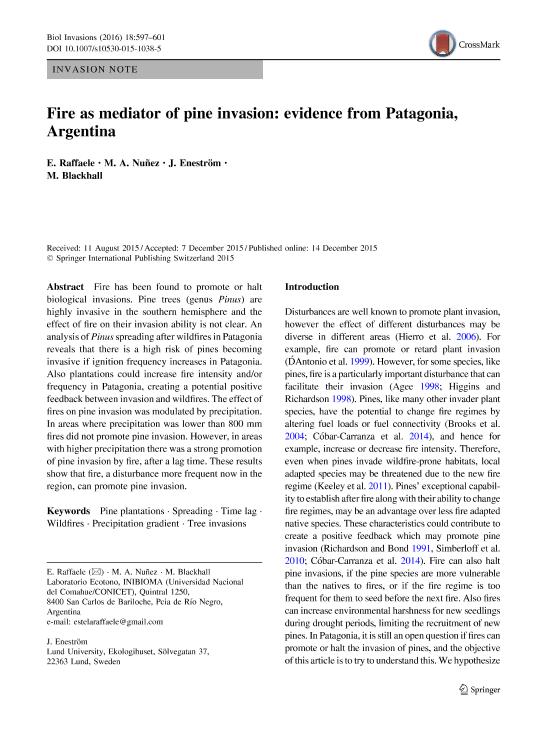Mostrar el registro sencillo del ítem
dc.contributor.author
Raffaele, Estela

dc.contributor.author
Nuñez, Martin Andres

dc.contributor.author
Eneström, J.
dc.contributor.author
Blackhall, Melisa

dc.date.available
2018-09-24T20:20:41Z
dc.date.issued
2016-03
dc.identifier.citation
Raffaele, Estela; Nuñez, Martin Andres; Eneström, J.; Blackhall, Melisa; Fire as mediator of pine invasion: evidence from Patagonia, Argentina; Springer; Biological Invasions; 18; 3; 3-2016; 597-601
dc.identifier.issn
1387-3547
dc.identifier.uri
http://hdl.handle.net/11336/60821
dc.description.abstract
Fire has been found to promote or halt biological invasions. Pine trees (genus Pinus) are highly invasive in the southern hemisphere and the effect of fire on their invasion ability is not clear. An analysis of Pinus spreading after wildfires in Patagonia reveals that there is a high risk of pines becoming invasive if ignition frequency increases in Patagonia. Also plantations could increase fire intensity and/or frequency in Patagonia, creating a potential positive feedback between invasion and wildfires. The effect of fires on pine invasion was modulated by precipitation. In areas where precipitation was lower than 800 mm fires did not promote pine invasion. However, in areas with higher precipitation there was a strong promotion of pine invasion by fire, after a lag time. These results show that fire, a disturbance more frequent now in the region, can promote pine invasion.
dc.format
application/pdf
dc.language.iso
eng
dc.publisher
Springer

dc.rights
info:eu-repo/semantics/openAccess
dc.rights.uri
https://creativecommons.org/licenses/by-nc-sa/2.5/ar/
dc.subject
Pine Plantations
dc.subject
Precipitation Gradient
dc.subject
Spreading
dc.subject
Time Lag
dc.subject
Tree Invasions
dc.subject
Wildfires
dc.subject.classification
Otras Ciencias Biológicas

dc.subject.classification
Ciencias Biológicas

dc.subject.classification
CIENCIAS NATURALES Y EXACTAS

dc.title
Fire as mediator of pine invasion: evidence from Patagonia, Argentina
dc.type
info:eu-repo/semantics/article
dc.type
info:ar-repo/semantics/artículo
dc.type
info:eu-repo/semantics/publishedVersion
dc.date.updated
2018-09-24T14:12:49Z
dc.journal.volume
18
dc.journal.number
3
dc.journal.pagination
597-601
dc.journal.pais
Alemania

dc.journal.ciudad
Berlin
dc.description.fil
Fil: Raffaele, Estela. Consejo Nacional de Investigaciones Científicas y Técnicas. Centro Científico Tecnológico Conicet - Patagonia Norte. Instituto de Investigaciones en Biodiversidad y Medioambiente. Universidad Nacional del Comahue. Centro Regional Universidad Bariloche. Instituto de Investigaciones en Biodiversidad y Medioambiente; Argentina
dc.description.fil
Fil: Nuñez, Martin Andres. Consejo Nacional de Investigaciones Científicas y Técnicas. Centro Científico Tecnológico Conicet - Patagonia Norte. Instituto de Investigaciones en Biodiversidad y Medioambiente. Universidad Nacional del Comahue. Centro Regional Universidad Bariloche. Instituto de Investigaciones en Biodiversidad y Medioambiente; Argentina
dc.description.fil
Fil: Eneström, J.. Lund University; Suecia
dc.description.fil
Fil: Blackhall, Melisa. Consejo Nacional de Investigaciones Científicas y Técnicas. Centro Científico Tecnológico Conicet - Patagonia Norte. Instituto de Investigaciones en Biodiversidad y Medioambiente. Universidad Nacional del Comahue. Centro Regional Universidad Bariloche. Instituto de Investigaciones en Biodiversidad y Medioambiente; Argentina
dc.journal.title
Biological Invasions

dc.relation.alternativeid
info:eu-repo/semantics/altIdentifier/url/https://link.springer.com/article/10.1007/s10530-015-1038-5
dc.relation.alternativeid
info:eu-repo/semantics/altIdentifier/doi/http://dx.doi.org/10.1007/s10530-015-1038-5
Archivos asociados
